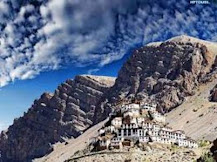Tayul Monastery, nestled in the
serene landscapes of the Himalayas, holds a rich tapestry of history and
spiritual practices that captivate visitors and practitioners alike. An ancient monastery in the northern region of India, the Tayul Gompa is
known for its 12 ft statue of Guru Padmasambhava. Founded several centuries ago, Tayul Monastery is a revered seat of Tibetan Buddhism, renowned for its unique
methodologies and diverse types of spiritual teachings.
History:
Founded in the 17th century, Tayul Monastery traces its
origins to the visionary Tibetan Buddhist masters who sought seclusion and
tranquility in the remote regions of Tibet. Over the centuries, it has served
as a beacon of wisdom and spiritual guidance for both local communities and
pilgrims from afar. The monastery's history is intertwined with tales of
resilience and devotion, surviving various challenges to maintain its sacred
traditions.
Methodology:
At the heart of Tayul Monastery's methodology lies the
practice of Vajrayana Buddhism, emphasizing esoteric rituals and meditation
techniques. Monks and practitioners engage in rigorous daily routines that
include chanting, meditation, and the study of Buddhist scriptures. The
monastery is known for its strict adherence to ritual purity and the
transmission of teachings through direct oral lineage, preserving ancient
wisdom for future generations.
Types:
Within Tayul Monastery, different types of spiritual
teachings cater to the diverse needs of practitioners. These include teachings
on philosophy (such as Madhyamaka and Yogachara), tantric practices (like deity
yoga and mandala offerings), and meditation techniques aimed at cultivating
mindfulness and compassion. Each type of teaching serves a specific purpose in
the spiritual journey, guiding individuals towards enlightenment and inner
peace.
Visiting Tayul Monastery offers a profound experience of
Tibetan Buddhist culture and spirituality. The architecture of the monastery
reflects traditional Tibetan styles, with colorful murals depicting Buddhist
legends and intricate mandalas adorning prayer halls. The tranquil
surroundings, set against the backdrop of snow-capped peaks and whispering
prayer flags, create an atmosphere conducive to deep contemplation and
spiritual renewal.
In conclusion, Tayul Monastery stands as a testament to the enduring legacy of Tibetan Buddhism,
where history, methodology, and diverse types of teachings converge to nurture
the spiritual growth of all who seek wisdom and enlightenment.
